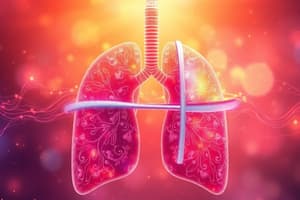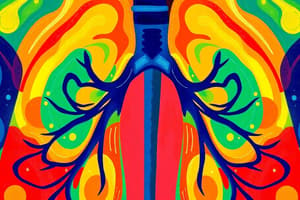Podcast
Questions and Answers
A patient with ARDS is on mechanical ventilation with FiO2 of 60%. Their PaO2 is 45 mm Hg. Based on the 50/50 rule, what is the most likely cause of their hypoxemia?
A patient with ARDS is on mechanical ventilation with FiO2 of 60%. Their PaO2 is 45 mm Hg. Based on the 50/50 rule, what is the most likely cause of their hypoxemia?
- Primarily a V/Q imbalance.
- Significant shunting. (correct)
- Increased carbon dioxide levels.
- Decreased hemoglobin levels.
How does oxygen primarily bind within the blood to facilitate its transport?
How does oxygen primarily bind within the blood to facilitate its transport?
- Dissolving directly into the plasma.
- Attaching to iron within hemoglobin inside red blood cells. (correct)
- Binding to carbonic anhydrase in plasma.
- Forming a complex with blood lipids.
What is the clinical utility of spectrophotometry (oximetry) in assessing a patient's respiratory status?
What is the clinical utility of spectrophotometry (oximetry) in assessing a patient's respiratory status?
- Assessing the pH balance of the blood.
- Determining the percentage of hemoglobin saturated with oxygen. (correct)
- Measuring the partial pressure of carbon dioxide in arterial blood.
- Quantifying the amount of nitrogen dissolved in the plasma.
A patient has a hemoglobin level of 10 g/dL, SaO2 of 95%, and PaO2 of 80 mm Hg. Using the CaO2 calculation formula, estimate their arterial oxygen content (CaO2).
A patient has a hemoglobin level of 10 g/dL, SaO2 of 95%, and PaO2 of 80 mm Hg. Using the CaO2 calculation formula, estimate their arterial oxygen content (CaO2).
In a patient with normal lungs, how are regional differences in ventilation and perfusion typically managed to optimize gas exchange?
In a patient with normal lungs, how are regional differences in ventilation and perfusion typically managed to optimize gas exchange?
According to Fick's Law of diffusion, which combination of factors would result in the greatest rate of diffusion?
According to Fick's Law of diffusion, which combination of factors would result in the greatest rate of diffusion?
Which of the following represents the correct order in which oxygen and carbon dioxide must pass through the structures in the alveolar-capillary membrane?
Which of the following represents the correct order in which oxygen and carbon dioxide must pass through the structures in the alveolar-capillary membrane?
Why is maintaining adequate transit time of red blood cells in the pulmonary capillaries essential for proper oxygenation?
Why is maintaining adequate transit time of red blood cells in the pulmonary capillaries essential for proper oxygenation?
Which of the following best describes the function of anatomic shunts
Which of the following best describes the function of anatomic shunts
A patient has a PaCO2 of 55 mm Hg. Based on the information provided, what change in alveolar ventilation ($V_A$) or carbon dioxide excretion ($V_E$)would likely help restore their PaCO2 to a normal level?
A patient has a PaCO2 of 55 mm Hg. Based on the information provided, what change in alveolar ventilation ($V_A$) or carbon dioxide excretion ($V_E$)would likely help restore their PaCO2 to a normal level?
What is the clinical significance of the alveolar-arterial (A-a) gradient in assessing a patient experiencing hypoxemia?
What is the clinical significance of the alveolar-arterial (A-a) gradient in assessing a patient experiencing hypoxemia?
During intense exercise, the transit time for red blood cells in the pulmonary capillary decreases to approximately 0.25 seconds. What physiological adaptation ensures adequate oxygenation despite this reduction in transit time?
During intense exercise, the transit time for red blood cells in the pulmonary capillary decreases to approximately 0.25 seconds. What physiological adaptation ensures adequate oxygenation despite this reduction in transit time?
A critically ill patient develops acute hypoxemia. What is the most likely underlying cause of hypoxemia in this scenario, according to text?
A critically ill patient develops acute hypoxemia. What is the most likely underlying cause of hypoxemia in this scenario, according to text?
Flashcards
Diffusion
Diffusion
Gas movement from high to low partial pressure areas.
O2 Cascade
O2 Cascade
Partial pressure gradient from inspired air to inside cells, driving O2 diffusion.
A/C Membrane Barriers
A/C Membrane Barriers
Alveolar epithelium, interstitial space, and capillary endothelium.
Fick's Law of Diffusion
Fick's Law of Diffusion
Signup and view all the flashcards
Transit Time
Transit Time
Signup and view all the flashcards
Anatomic Shunt
Anatomic Shunt
Signup and view all the flashcards
Normal Anatomic Shunts
Normal Anatomic Shunts
Signup and view all the flashcards
A-a Gradient
A-a Gradient
Signup and view all the flashcards
50/50 Rule for Hypoxemia
50/50 Rule for Hypoxemia
Signup and view all the flashcards
ARDS
ARDS
Signup and view all the flashcards
Oxygen Transport in Blood
Oxygen Transport in Blood
Signup and view all the flashcards
Oxyhemoglobin Dissociation Curve
Oxyhemoglobin Dissociation Curve
Signup and view all the flashcards
Hemoglobin Saturation (SaO2)
Hemoglobin Saturation (SaO2)
Signup and view all the flashcards
Study Notes
- Gas exchange between lungs and tissues happens through simple diffusion.
- The partial pressure of oxygen (PO2) decreases gradually from 159 mm Hg when inspired to 40 mm Hg or less in the capillaries.
- Intracellular PO2 (around 5 mm Hg) drives O2 diffusion into the cell.
- Normal values for PaCO2 are 35 to 45 mm Hg while healthy is 40 mm Hg.
- If PaCO2 increases then Va/Ve decreases.
Fick's Law of Diffusion
- Diffusion increases with greater surface area, diffusion constant, and pressure gradient.
Alveolar-Capillary (A/C) Membrane
- The A/C membrane has three barriers:
- Alveolar epithelium.
- Interstitial space and structures.
- Capillary endothelium.
Mechanism of Diffusion
- Gas molecules move from high to low partial pressure areas.
- O2 and CO2 must pass through several barriers to diffuse into and out of the lungs and tissues.
Barriers to Gaseous Diffusion
- The alveolar-capillary membrane is the major barrier.
- CO2 and O2 must pass through these three barriers:
- Alveolar epithelium.
- Interstitial space.
- Capillary endothelium.
- Gases must also pass through the red blood cell membrane.
Time Limits to Diffusion
- Blood must stay in contact long enough with the alveolus for proper oxygenation.
- Normal red blood cell transit time in the pulmonary capillary is about 0.75 seconds.
- Blood PO2 reaches equilibrium with alveolar PO2 before the capillary end.
- During exercise transit time is .25 seconds.
Anatomic Shunts
- A shunt returns cardiac output to the left heart without oxygenation from ventilated alveoli.
- Two types of right-to-left anatomic shunts:
- Bronchial venous drainage.
- Thebesian venous drainage.
- Normal A-a gradient is 5-10 mmHg, where A = alveolar and a = arterial.
V/Q Imbalance
- V/Q imbalance is the most common cause of hypoxemia in respiratory diseases
- Shunting is also a common issue, especially in critically ill patients
- If FiO2 is greater than 50% and PaO2 is less than 50 mm Hg, then significant shunting is present.
- Otherwise, the hypoxemia is mainly due to a V/Q imbalance.
Ventilation/Perfusion Ratio Alterations
- In healthy lungs, regional ventilation differences match perfusion differences, maintaining a V/Q ratio close to 1.
- Patients with ARDS have gas exchange abnormalities from fluid in the alveoli.
- Requires ventilation with high FiO2 and PEEP.
Oxygen Transport
- Blood carries O2 in two forms:
- A small amount dissolves in plasma and erythrocyte fluid.
- Most O2 binds to hemoglobin (Hb) inside red blood cells.
- 1 g of normal Hb can carry about 1.34 mL of O2.
- The average blood Hb content of 15 g/dL determines the blood's O2-carrying capacity.
- The oxyhemoglobin dissociation curve indicates the likely hood for oxygen to offload at the lungs/tissues.
Hemoglobin
- Binds with iron.
- When 02 binds with Hb it changes its shape so it will reflect or absorb light differently which means:
- Bright red is arterial.
- Spectrophotometry (oximetry) measures the amount of Hb saturated.
- If 10 Hb molecules all carry four O2 molecules, the saturation is 100%.
- Normal Hb value is 12-16.
Hemoglobin Saturation
- Saturation measures the proportion of available Hb carrying oxygen.
- SaO2 = (HbO2/total Hb) x 100.
CaO2 Calculation
- CaO2 = (Hb x 1.34 x SaO2) + (PaO2 x 0.003).
- Normal CaO2 value is 17-20%.
Studying That Suits You
Use AI to generate personalized quizzes and flashcards to suit your learning preferences.




